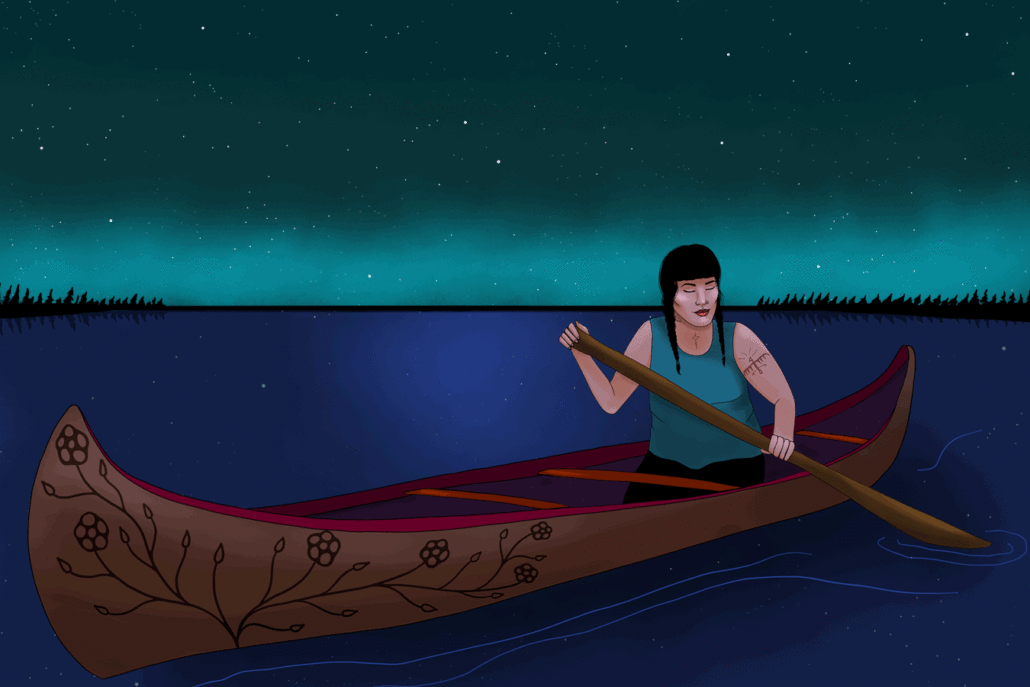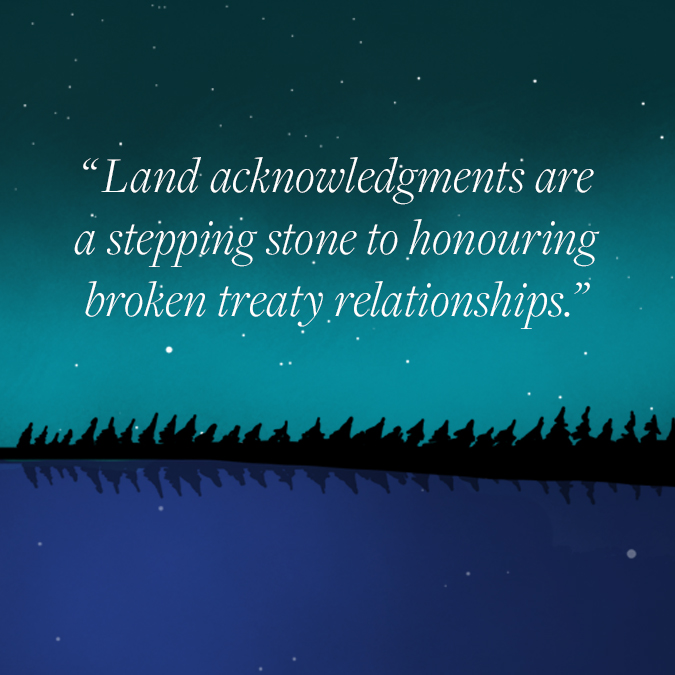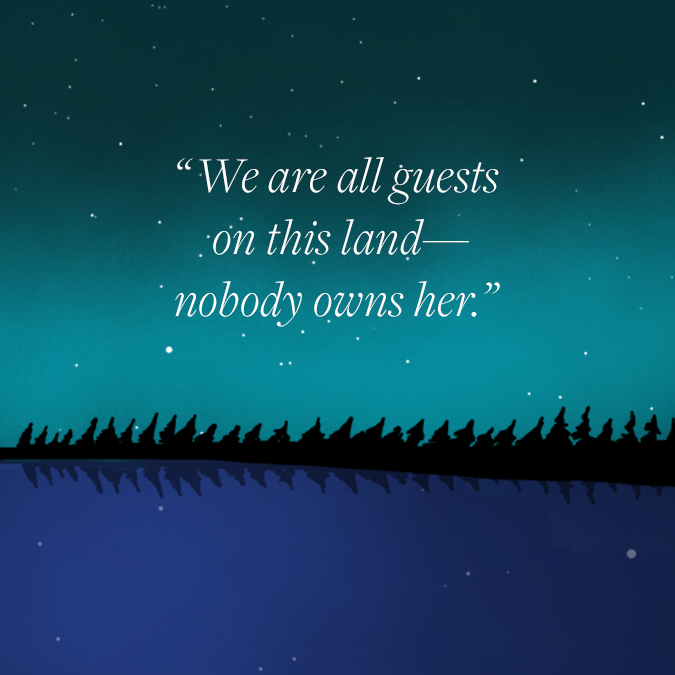
Indigenous writer Selena Mills illustrates the importance of land acknowledgements—and shares perspectives about this newly popular form of reconciliation
Chances are, you’ve seen or heard a land acknowledgement at some point in the past few years. Maybe this was during the introduction to an art, sporting, cultural, academic or civic event, or at one of the 160 Toronto bus shelters that now ask transit users to think about who first lived on the land they’re commuting across. We know that Columbus did not discover the Americas, nor did the other European seafarers who preceded him. This land was—and still is—Turtle Island, already inhabited for well over 10,000 years by thriving traditional territories, bands and confederacies of Indigenous people. And we’re still here, in spite of intense and prolonged attempts by church and state to assimilate and colonize Indigenous peoples into white/Eurocentric society. But maybe you don’t totally understand why land acknowledgements are so important. That’s understandable—we can’t know what we weren’t taught, right? So, here’s what you need to know.
What is a land acknowledgement?
Land acknowledgements are an honest and historically accurate way to recognize the traditional First Nations, Métis and/or Inuit territories of a place. They can be presented verbally or visually: think signage, short theatre presentations or simple spoken-word greetings. According to Anishinaabe-kwe Wanda Nanibush, the first curator of Indigenous art at the Art Gallery of Ontario (AGO), land acknowledgements have one goal, regardless of format: They commemorate Indigenous peoples’ principal kinship to the land—and the fact that we have not and cannot be erased from her, our collective first mother. “They’re a starting place to a change in how the land is seen and talked about,” she says. “[They] help redefine how people place themselves in relation to First Peoples.”
Nanibush spearheaded the installation of multilingual labels for the AGO’s permanent collection of Canadian and Indigenous art, which is housed in the newly renamed J.S. McLean Centre for Indigenous & Canadian Art. The labels are published in English, French and Inuktitut or Anishinaabemowin, the latter of which is the language of the land the AGO occupies. (Ojibway is a dialect of Anishinaabemowin.) “It’s important for our audiences to grapple with the idea of the inherent right to land that First Peoples actually hold,” Nanibush says. “If it isn’t stated everywhere, all the time, people can continue to ignore its existence.”
Why are land acknowledgements necessary?
Inspired by the 94 recommended calls to action contained in the Truth and Reconciliation Commission of Canada (now known as the National Centre for Truth and Reconciliation, or NCTR), land acknowledgements are a necessary first step toward honouring the original occupants of a place. They also help Canadians recognize and respect Indigenous peoples’ inherent kinship beliefs when it comes to the land, especially since those beliefs were restricted for so long.

When we’re being honest about why land acknowledgements are important—recognition of the attempted genocide of Indigenous peoples in Canada, which spans centuries—they might seem like an inadequate gesture. But the NCTR’s recommendations help provide a solid framework for reconciliation for the injustices that have been carried out against Indigenous communities: broken treaty relationships, residential schools, the Sixties Scoop, and continued attempts by government (federal, provincial and territorial) and religious groups to control the Indigenous family unit, resources and access to services. I think that understanding colonization isn’t just a historical problem—it’s also a key component in grappling with why land acknowledgements are important today. Generations of Canadians have been affected—not just the oppressed.
Land acknowledgements aren’t about placing blame, and not all Indigenous peoples agree on their efficacy or even on how they should be done—especially when they are sloppy, done without Indigenous consultation or don’t reflect actual Indigenous inclusion and representation within organizations as a whole. Part of the point in making land acknowledgements is to recognize how systemic and institutional systems of power have oppressed Indigenous peoples, and how that oppression has historically influenced the way non-Indigenous people perceive and interact with Indigenous peoples—all still quite prevalent in today’s cultural, social and political climate.
How should I react during a land acknowledgement?
Be mindful of the thoughts that go through your head when you hear or see a land acknowledgement. Digging deep to look at how our personal biases might contribute to discrimination can be tough, but the work of personal introspection isn’t supposed to be easy. Be honest with yourself about your first reactions and the commentary that ensues when we hear a land acknowledgement with our peers, or when your kids talk about hearing them at school. Today’s land acknowledgements contradict what many of us were taught, even if we’ve been out of school for just a few years—not to mention with how our own Canadian identity is reflected through our family histories. Know that proving and understanding identity is something that First Nation, Métis and Inuit people have to do every day.
When we start to connect the necessary dots to gain a thorough understanding of why land acknowledgements are important, we’re faced with some harsh truths about injustices that have happened—and are still happening—right here in Canada, often carried out by institutions we’ve believed in and trusted. These are big things to grapple with, and you’ll find that most Indigenous people are understanding of that.
Sara Roque, a filmmaker who worked for years as the Indigenous arts officer at the Ontario Arts Council (OAC), has seen many land acknowledgements, both across Turtle Island and in other Indigenous communities such as in Australia and New Zealand. She understands how the scripted ones can be seen as a “yawn”—it’s a reaction she has witnessed from both audiences and jury panels and adds that it quickly becomes clear when speakers either don’t have a full understanding of land acknowledgements or are just reciting words.
Recognizing how generations before us have individually oppressed others doesn’t necessarily mean we are admitting to being bad people today. And holding one another accountable when it comes to self-reflection can seem like a tall order, too. But these are important things to think about—and more importantly, they’re actionable steps toward legitimate reconciliation.
Is there a wrong way to do a land acknowledgement?
Perhaps. I’m still on the fence. In my opinion, when they are dry, scripted and obviously hold no meaning to the speaker, I am critical—but I also appreciate that at least they’re being done in more and more spaces. Other peers and community members I’ve talked to about land acknowledgements say that many of them are very obviously less about accuracy and more about doing something in the name of “reconciliation” without doing anything else. Stumbling over some words just isn’t enough—Indigenous programming and leadership should also be consistently reflected throughout the event, workshop or curriculum.

Roque looks to the origins of land acknowledgements amongst Indigenous peoples as inspiration and testimony to their importance, sharing that First Peoples often placed themselves in relation to their connection to the land they were born from (in), describing that Indigenous peoples recognize and honour their connection to the land. It’s about relational location: having an umbilicus to where you’re from and how to follow it. These introductions weren’t labelled as land acknowledgements—it was just how we carried and presented ourselves when gathering for governance and ceremony. Sometimes a verbal announcement wasn’t even necessary, as clan and territorial signifiers were present by way of dress, types of hides, tattoos and art weaved into all forms of aesthetics. Today, some Indigenous peoples might introduce themselves in their language and claim the land they are from, along with their name.
Years of experience have shown Roque that real change—such as land acknowledgements being more than just a rote exercise—doesn’t happen without institutions walking with integrity by supporting and properly consulting with Indigenous practitioners. She describes a surface approach of political correctness: checking off a box without really investing in learning what the motive or mandate requires, or its historical relevance.
“I think of the practice of giving tobacco as an Indigenous person. You can do that for years and years and it starts to feel like a performativity task and you ask yourself, ‘Why am I doing this?’,” she says. “I think when land acknowledgements are approached with humility and as a learning opportunity, that knowledge and that learning process can be transmitted to others.” Roque advocates taking a collaborative approach, which includes considering “how land acknowledgements are [handled] to reflect an inclusion of Indigenous worldviews, and challenging and rebalancing the whole idea that Indigenous people have been erased from the history of this land.”
Roque agrees that research and consultation are integral to this process. “It would be so neat to see [land acknowledgements] done more frequently in the languages representative of regions, wherein the words are embodied though an impactful, opening performance,” she says. “I have seen variations and interpretation like this and the audience was deeply impacted.”
What else do I need to know?
As Canadians, we have to understand that Indigenous people are healing and that each person’s healing path is as different as their life experiences. Stop talking. Listen. You’ll hear a perspective that you’ve never heard before that relates first-hand to centuries of oppression, but also a story of strength and resurgence.
We can effect real change by pushing ourselves to engage in conversations with each other. That’s the goal for all of us, as professionals and community members, especially if we are in positions of power to create change and understanding. Because we are all guests on this land—nobody owns her. But it’s the First Peoples who are her stewards and direct descendants, who hold the ancestral and genetic blood memory, knowledge of enriching philosophies, land-based skills and intrinsic belief systems that future generations will depend upon, regardless of cultural lineage. It’s not so much about focusing on the omission of belonging, and all of us having a right to a home, but rather about introducing non-Indigenous people to this land’s accurate confederate history and the importance of relationship to land despite the dominant worldview of owning the land. All we’re asking you to do is to remember, and remember with us.
Recommended reading & resources
• Beyond territorial acknowledgements (âpihtawikosisân)
• Canadian Association of University Teachers: Guide to Acknowledging First Peoples & Traditional Territory
• Land acknowledgements – video (Whose Land)
• Land acknowledgements are a good first step, but there’s a lot more work to be done (Today’s Parent)
• Tide is turning on Canada’s relationship with Indigenous people (The Globe and Mail)
• Why our kids need to learn about residential schools (Today’s Parent)